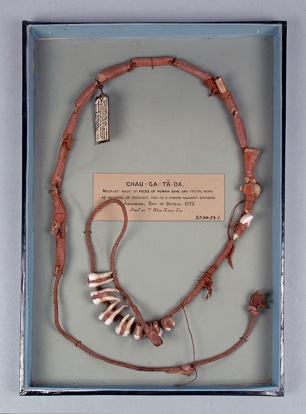Chau-ga-ta memorial necklace
Andaman Islands, India, 19th century
 Possibly transferred from the University Museum in 1886; 2000.57.1The necklace is of a type particular to the Andaman Islands, a group of islands in between India and Myanmar (Burma). It is called a chau-ga-ta. It is made of pieces of human bone rib or finger bones, which have been tied together with plant fibre and stained with red ochre. The end of the necklace has also been decorated with human teeth.
Possibly transferred from the University Museum in 1886; 2000.57.1The necklace is of a type particular to the Andaman Islands, a group of islands in between India and Myanmar (Burma). It is called a chau-ga-ta. It is made of pieces of human bone rib or finger bones, which have been tied together with plant fibre and stained with red ochre. The end of the necklace has also been decorated with human teeth.
Friends and relatives wore chau-ga-ta necklaces as a memorial to the deceased. They were also worn as a charm against sickness or by those suffering from an ailment, the necklace strung tightly around the part of the body that was in pain.
In times past, many of these necklaces were made with animal bones instead of human bones to trade with Europeans. There are few Andamanese living a traditional lifestyle on the islands now and chau-ga-ta are still made but moulded and painted clay is usually used instead of bone of any sort.
